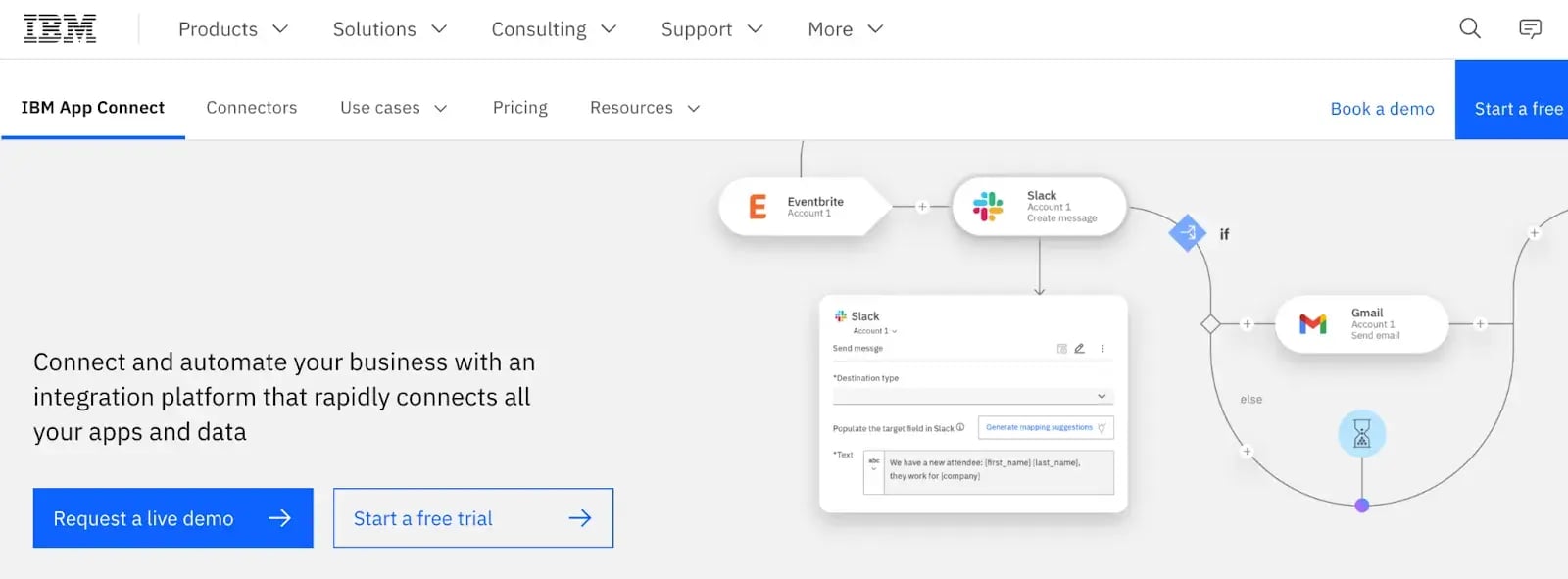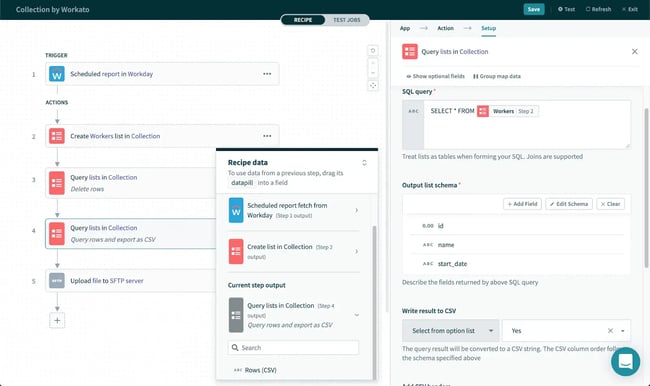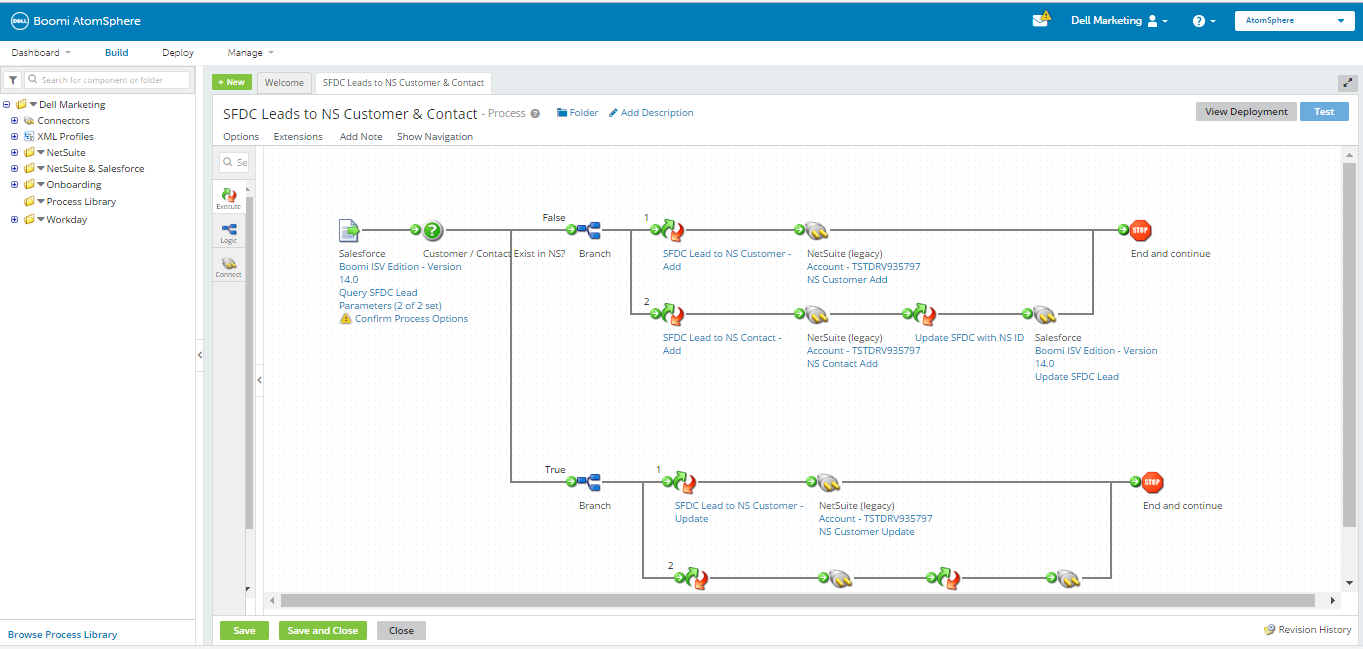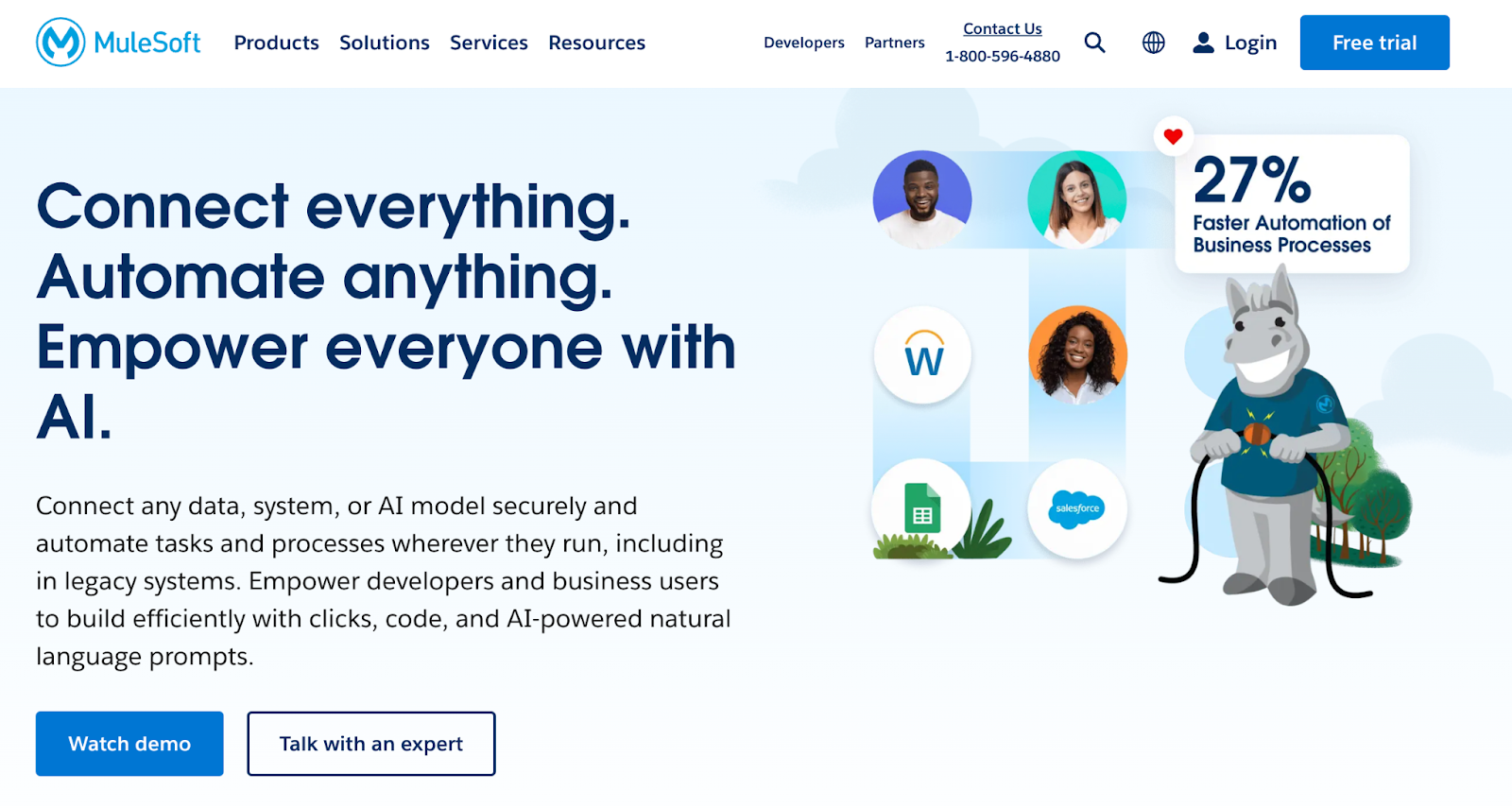Table of Contents
What is integration automation?
Integration automation allows technology to automatically transfer data between different systems and applications. With this process, there’s no need for manual data entry, lowering the risk of human errors. In today’s data-heavy world, integration automation allows businesses to process and store the information they generate.
With integration automation, you can also transfer data. That could be between technology systems, between different software platforms, or different departments of your organization.
Increased access to information can help businesses develop a competitive advantage. You can effectively make data-driven decisions. That includes building targeted campaigns for different segments and keeping better track of the user experience.
The Benefits of Automation Integration
Automating integration can bring a multitude of benefits to businesses of all sizes. Here are some of the key advantages.
1. Time-saving
While certain tasks require a human touch, helping machines communicate drains your resources. Instead of giving your team opportunities to excel, they’re stuck inputting information manually.
Automating the integration process can help businesses save time by removing the requirement for manual data entry and transfer. Your employees can concentrate on more strategic tasks that require human expertise. No one has to be left with the frustrating task of data entry.
2. Cost-effective
Manually logging data into a spreadsheet is tedious. We’ve all done it. When I’m dozens of lines of data into the process, all the numbers start looking the same. That increases the odds of making a mistake, which can have big financial repercussions.
With integration automation, you can avoid costly errors that can come from manual data entry. Plus, you can have your data team focus on more important strategic tasks, freeing up their time and your budget.
3. Improved Productivity
Integration automation enables different tools and systems to work seamlessly together. This allows information to flow quickly, without the need for manual intervention. With automated workflows, processes become more efficient, reducing bottlenecks and ensuring tasks are completed faster.
This process also facilitates the sharing of data and information between teams and departments. With integrated systems, employees can access the same, updated data in real time. Teams can work together on projects and decision-making based on accurate and consistent information, improving productivity.
4. Enhanced Customer Experience
Your customers don’t want to be left in the dark. If they make a purchase, they’ll want fulfillment information. If they buy a seat on your software platform, they’ll expect changes that make the experience better.
Automating processes like order fulfillment and customer support can provide quicker, personalized service to customers. You can then meet their needs more efficiently, resulting in increased loyalty to your brand..
By taking advantage of integration automation tools and technologies, businesses can stay competitive and thrive in today's fast-paced digital landscape.
Integration Examples
Now, let’s delve into three examples of integration so you can see how it benefits businesses.
Data Integration
Data integration combines data from different sources into a single, unified structure and view. It takes large amounts of data, processes it, and organizes it for users to access. This process turns raw data into useful information and actionable insights. Data integration also breaks down information silos.
Data integration allows businesses to function more efficiently since information is shared across the organization, resulting in better collaboration. It also provides clean, comprehensive, and readily available data for use.
In the Real World
Let’s take a look at Amazon, where we can see data integration in action. Let’s say I order a disco ball to spruce up a birthday party for a friend. Once I hit purchase, Amazon integrates real-time order data and logistics information.
I know exactly where my disco ball is in the shipping process. I’ll get up-to-date tracking information and an accurate projection of when my package will arrive. By integrating data from the shipping provider with their own systems, Amazon provides a transparent and reliable order tracking experience.
What we like: Whether you’re a small or enterprise business, integrating data will improve your workflows, customer relations, forecasting, and plans for growth.
Application Integration
Application integration is the process of enabling various applications to work with one another. While each app is designed for its own purpose, integrating them can help your internal and external workflows and processes run more smoothly. Sharing data across applications also becomes possible.
Application Programming Interfaces (APIs) are a popular way for developers to integrate software. The applications will be able to speak to one another or to respond when triggered by an event in another app. Unlike data integration, integrated applications become a functional system that operates in close to real-time.
In the Real World
To better understand this process, let’s look at how Slack integrates with HubSpot. When there are updates or changes in the deal stages within HubSpot's CRM, these updates can be automatically sent to designated Slack channels.
This integration ensures that both marketing and sales teams are aware of the progress and developments in each deal, facilitating better coordination and alignment.
What we like: Integrating applications creates a new level of functionality and efficiency for your business.
Cloud Integration
Cloud integration means connecting data and applications in the cloud to your infrastructure or other cloud services. This can prevent data from becoming lost, overlooked, or siloed.
Cloud integration allows for flexibility in how data is stored and shared. Team members can access data anytime and get updates in real time. You can integrate data, applications, systems, IT environments, and repositories in the cloud, creating a powerful infrastructure for your organization.
In the Real World
To better understand cloud integration, let’s look at Netflix. The company uses cloud integration to collect and analyze how users interact with the platform. This helps the company understand engagement, user preferences, and viewing patterns. It can then make better recommendations.
Netflix may notice that I binged the latest season of Stranger Things. By gathering data on what I watch, the platform can then recommend 80’s movies with the same vibes.
What we like: Cloud integration allows for real-time digital data transfer, speeding up delivery times.
Integration Automation Tools
Now, let’s look at some integration automation tools with their core features, differentiators, and pricing so you can find the best fit for your business. Let’s dive in.
1. HubSpot Operations Hub

HubSpot’s Operation Hub automatically syncs customer data between different systems and tools. It has a user-friendly interface for creating integrations and offers pre-built templates for popular integrations.
What we like: Operation Hub’s intelligent sync rules make it easy to customize how data is synced between different systems.
Best for: Small- to enterprise-sized businesses looking for a two-way sync automation tool.
Pricing: Free plans are available. Starter plans cost $45 a month. Professional plans cost $720 a month. Enterprise plans cost $2,000 a month.
2. Integrate.io

Integrate.io is a cloud-based, automated Extract, Transform, and Load (ETL) solution. It has an intuitive user interface and is accessible to anyone — no coding required. You can build data pipelines quickly and easily so information can flow seamlessly throughout your organization.
What we like: The platform is good at large-volume integrations and complex transformations.
Best for: Data teams, rev ops, line of business, and marketing executives.
Pricing: Starter plans cost $15,000 a year. Professional plans cost $25,000 a year. Enterprise pricing is available upon request.
3. Azure Logic Apps
Azure Logic Apps is a service that allows businesses to create integrations that are scalable and reliable. It’s cloud-based and offers a visual designer for creating workflows. It also has pre-built connectors for popular systems and applications.
What we like: Azure Logic Apps integrates seamlessly with other Azure services, making it easy to create end-to-end solutions.
Pro tip: Businesses can use Azure Logic Apps to automate repetitive tasks and reduce manual labor.
Pricing: Contact Microsoft for pricing.
4. IBM App Connect
IBM App Connect is an enterprise-level integration platform that allows businesses to connect data and applications across multiple systems. It offers a drag-and-drop interface for building integrations. There are also pre-built connectors for a wide range of systems and applications.
What we like: IBM App Connect provides advanced mapping and transformation capabilities, making it easy to transform data between different systems.
Best for: Large enterprises with complex integration needs.
Pricing: iPaaS starts at $667 a month. Contact IBM for enterprise pricing.
5. Jitterbit

The Jitterbit Harmony Platform is a cloud-based integration platform that allows users to easily create integrations using a drag-and-drop interface. It also includes pre-built connectors for various popular systems and applications.
What we like: Jitterbit Harmony Platform offers advanced API management capabilities, making it easy to create and manage APIs.
Best for: Businesses looking for a cloud-based integration solution with advanced API management capabilities.
Pricing: Custom pricing is available based on your needs.
6. Zapier

Zapier is a tool that automates workflows and enables businesses to connect different apps easily. With a user-friendly drag-and-drop interface, users can create their own integrations or choose from ready-made templates. Zapier supports over 3,000 apps, including popular options like Salesforce, HubSpot, and Shopify.
What we like: Zapier's user-friendly interface makes it easy for non-technical users to create integrations.
Best for: Small- to medium-sized businesses looking for a simple integration solution.
Pricing: Plans start at $19.99 a month.
7. Workato 
Workato is a platform that enables businesses to connect and automate their workflows across various applications. It offers a visual interface to create integrations and has pre-built connectors for a variety of systems. Workato is compatible with more than 1,000 apps, some of which are Slack, Salesforce, and Zendesk.
What we like: Workato's advanced mapping and transformation capabilities make it easy to transform data between different systems.
Best for: Medium- to large-sized businesses with complex integration needs.
Pricing: Plans start at $499 a month.
8. Dell Boomi

Dell Boomi is a cloud-based platform used by businesses to connect data and applications across different systems. It has a user-friendly interface that allows users to easily create integrations.
It already has over 200 apps that it can integrate with, including Salesforce, SAP, and Oracle. Additionally, it provides a large library of pre-built integration templates for systems and applications, making it easy to get started.
What we like: Dell Boomi's advanced security features make it a popular choice for large enterprises with strict security requirements.
Best for: Large enterprises with complex integration needs.
Pricing: Contact Dell Boomi for pricing.
9. Anypoint Platform by MuleSoft

The Anypoint Platform by MuleSoft provides a complete solution for integrating devices, applications, and data. Businesses can establish connections between almost any system or application using pre-built connectors and templates.
What we like: The interface of MuleSoft Anypoint Platform is user-friendly, which simplifies the creation, testing, and deployment of integrations.
Best for: Businesses looking for a scalable and flexible integration solution.
Pricing: MuleSoft has three pricing brackets for Anypoint, but you must contact them for a quote.
10. Microsoft Power Automate

Microsoft Power Automate is a tool that helps businesses automate tasks and workflows by integrating with over 400 apps, including Office 365, SharePoint, and Dynamics 365. It comes with pre-built templates for popular integrations and offers a visual interface for creating custom workflows.
What we like: Microsoft Power Automate's deep integration with other Microsoft products makes it a popular choice for businesses that use Microsoft products.
Best for: Businesses that use Microsoft products and want to automate workflows.
Pricing: Plans start at $15 per user a month.
Getting Started
Integration automation plays a vital role in modern business operations. It enables businesses to simplify workflows, enhance data accuracy, and boost efficiency.
When it comes to integrating automation, it‘s crucial to assess various tools and solutions to determine what’s best for your business. With the abundance of integration automation tools on the market, it's important to take into account features, integrations, pricing, and ease of use before making a decision.
Integrations












